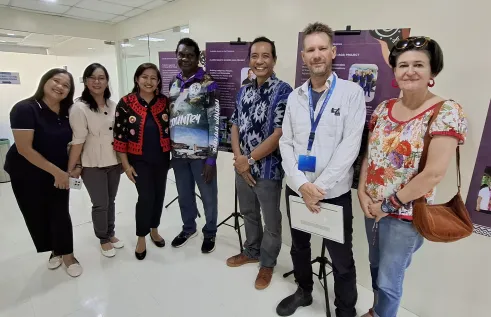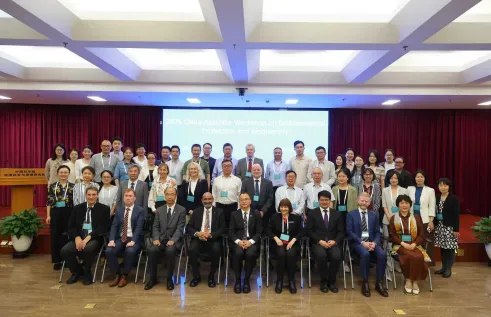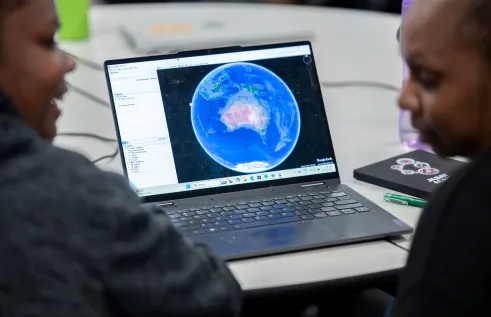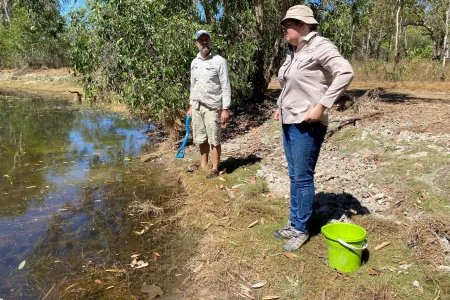RIEL news
Rising tides: wetland simulations for a climate-affected future
In an aquaculture laboratory nestled in a distant corner of Charles Darwin University’s Casuarina campus, a PhD student is nurturing hundreds of tiny, simulated wetlands that she hopes will tell her how one of the Northern Territory’s most celebrated environments will fare with the effects of climate change.
Tegan Dedman has, for several years now, been taking very small samples of wetland soil from Territory floodplains into takeaway containers in labs to see how they will cope with artificially increased salinity.
“I’ve been to nine wetlands around the Top End to scoop up some soil, generally dry soil, that come the wet season will be flooded into a wetland. From there, I add the water to the soil myself and see what begins to grow.” Says Tegan.
Tegan wants each takeaway container to house a micro-environment that is as close to a real wetland as possible.
“Pretty quickly, seeds in the soil will germinate and tiny eggs can hatch, so we get small invertebrates such as snails and micro-crustaceans emerging. Once the wetland has come back to life, I can begin the experiments.” Said Tegan.
These wetland experiments are about trying to predict the future, when the Territory’s natural landscapes are forced to adapt to a changing climate.
“We anticipate that sea-level rise, which is already affecting coastal wetlands, will result in many of our wetlands experiencing increasingly prolonged periods of high-salinity as salt water pushed on tides and through the groundwater makes its way up into freshwater systems.” Tegan said.
Tegan is using the takeaway containers to simulate wetlands that are experiencing different levels of salinity.
“We have containers with totally fresh water right through to containers that have straight sea-water added to them. All the wetland samples were taken from entirely freshwater wetlands, so by creating a salinity gradient across all our wetland simulations, we can see how wetlands cope with a small salinity increase, right through to complete seawater inundation.” Says Tegan.
Tegan is also in the process of upscaling these experiments, and now has a number of 450L cattle tanks to create larger wetland simulations that allow more fine scale observations of the effects of salinity.
“With larger tanks, I can analyse the fatty acid content of the plants and animals in each simulation. Fatty acid profiles can tell us about the quality of food resources in a food web, and we expect food quality in the food webs with higher salinity to deteriorate.” Tegan said.
Tegan hopes her research will better inform predictions of the impact of climate change and associated sea-level rise on Top End Wetlands.
“By the time these experiments are finished, we should have a much better idea how increasing salinity – right up to straight seawater – effects the productivity of freshwater wetlands at a range of trophic levels.” Says Tegan.
Tegan’s project is supervised by Dr Keller Kopf, Dr Erica Garcia and Prof. Jenny Davis.
Tegan’s project is funded by Charles Darwin University and the Australian Government Research Training Program and is conducted on the lands of the Larrakia, Wulna, and Limilngan People.
Related Articles

Environmental researchers and rangers visit Philippines as part of NT-Philippines exchange
CDU researchers and representative from Dhimurru Aboriginal Corporation completed a valuable exchange with Philippine leaders and rangers in June 2025.
Read more about Environmental researchers and rangers visit Philippines as part of NT-Philippines exchange
Professorial delegation discusses environmental protection and biodiversity in Beijing
Charles Darwin University (CDU) academics were among a high-level Australian delegation that visited the Chinese Academy of Sciences (CAS) last month.
Read more about Professorial delegation discusses environmental protection and biodiversity in Beijing
Rangers and PhD candidate unite at mapping workshop
How can technology support the revival of knowledge, its intergenerational transmission, and the defense of ancestral lands, all while ensuring cultural protocols are upheld?
Read more about Rangers and PhD candidate unite at mapping workshop
